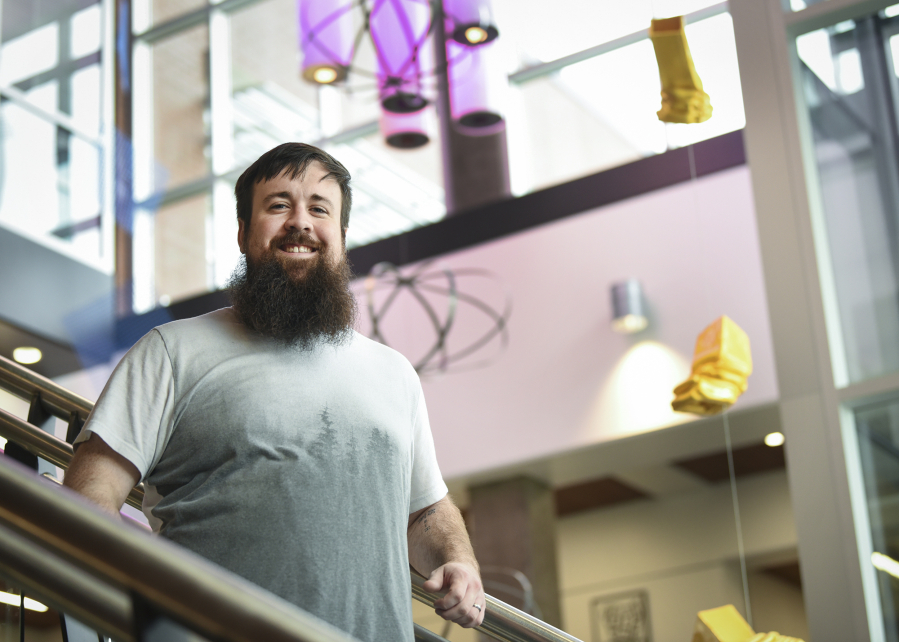When Cody Messick switched his major from theater to physics, the drama was just beginning.
And when he recently was recognized as a star, it was not for his work on Broadway.
Which actually was Messick’s goal when he enrolled at Clark College.
“The dream was to get an acting degree, move to New York City, work as a waiter and make it big,” Messick recalled during a recent return to the Clark College campus.
Messick is among hundreds of scientists who took part in a project that documented one of the most dramatic events in physics. In October, the leaders of the LIGO project received the Nobel Prize in physics.
Their research confirmed the existence of gravitational waves, a scientific quest that started when Albert Einstein announced his theory of general relativity in 1916.
Messick, a grad student at Penn State University, was part of the LIGO project, shorthand for Laser Interferometer Gravitational-Wave Observatories. The network includes a Washington facility at Hanford.
Messick, a 2008 Prairie High grad, is one of two local products who were part of the LIGO project.
Jenne Driggers, who attended schools in the Evergreen district, works in the LIGO lab in Hanford. She is a postdoctoral researcher at California Institute of Technology in Pasadena, Calif.
While the Nobel Prize went to Kip Thorne and Barry Barish of the California Institute of Technology and Rainer Weiss of the Massachusetts Institute of Technology, both local scientists were feeling pretty good about their roles in the supporting cast.
Messick is listed as an author on one of the publications, and he observed: “I think 1,014 names were on the paper.”
Driggers made a similar one-in-a-thousand reference.
“While of course the prize actually goes to Rai, Kip, and Barry, I feel like I’ve won 1/1000th of a Nobel Prize, too,” Driggers told The Columbian in an email message in October, when the award was announced.
Clark’s Rising Star
Messick and his wife, fellow Clark alum Kasey Cannon, were back on campus last month when he was honored as the Clark College Foundation’s 2017 Rising Star. The award honors Clark alums 35 and younger.
During their visit, the couple looked back on their shared path. Cannon graduated from Prairie High in 2009, a year after Messick. When she went to Clark, she saw a familiar face.
“We started dating when I ran into him in class,” Cannon said.
As they compared notes, Messick said that he was a drama major. Cannon’s response, she said, was punctuated by what was very much a dramatic pause: “That’s … cute.”
They had a friendly competition to see who could compile the better grade-point average.
“I thought I was gonna kill him. I was an honor student” in high school, said Cannon.
And Messick?
“I was a 1.9,” he said, referring to his high school GPA.
So what happened?
“He beat me,” said Cannon, who was a chemistry major at Clark. In the second quarter, “He beat me again. Third quarter, we didn’t compete.”
Former physics instructor Dick Shamrell, who taught them both, said that Messick’s story represents one of Clark’s missions.
“He came to Clark with kind of a blank slate. He hadn’t found his academic way yet,” Shamrell said. “Our goal is to help them realize their potential, whatever it is. We do that every day. We light the fire, and we don’t necessarily know how it happened.”
“We’re all born with a science gene,” Shamrell said. “Sometimes it gets turned on even more, and sometimes it gets shut down.”
The initial step was a general physics class, Shamrell said.
“It’s how the universe works. Cody moved to engineering physics,” which has more advanced math, Shamrell said.
That was one of several turning points, Messick said: “I realized that I hate engineering and like math.”
Right place, right time
After transferring to the University of Washington, his path shifted again — another example of being in the right place at the right time. A biophysics major, Messick was an officer in a campus club for science students.
“I only heard about LIGO because I wanted to get people interested in the club with a field trip. Seattle was a three-hour drive from Hanford.”
After putting up fliers, he had some explaining to do. People asked: “What’s a gravitational wave?”
He replied: “I have no idea.”
But once he saw the LIGO lab, “I was blown away,” Messick said.
He now is a doctoral candidate in physics at Penn State, where he found an opportunity to participate in LIGO research. Again, timing was everything.
“My adviser was the link. I was extremely lucky. I was the first person to meet him,” Messick said. “Six months later, there were two slots and I got one because I’d showed up early.”




